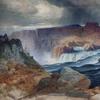The Art of Carl Gustav Jung Is Brought Together in a Slightly Mind-Blowing Exhibition
- February 05, 2019 11:55


Jung's most astonishing creation was The Red Book (1915–c.1930), a book he illustrated and hand-wrote in the manner of a medieval manuscript illuminator. This fascination with the Middle Ages began with his earliest childhood drawings of castles and continued to the tower of Bollingen, the retreat he designed and built on the shores of Lake Zurich. Early on, he painted landscapes filled with a transcendental longing that would imbue his mature analytical work. Jung was well-versed in the conventional tastes of his day; but his vision quickly grew to include art from around the world and throughout time: ancient Assyrian reliefs, African sculpture, Native American Zuni dolls, Tibetan mandalas. Jung knew many of the Dada artists who made their home in Zurich. He appreciated works by symbolists and surrealist painters like Yves Tanguy and Salvador Dali. Some of his own work can even be read as abstract, but the symbolic content was always of paramount importance to Jung.
This exhibition contains the majority of Jung’s artistic oeuvre, as well as many of his manuscripts and books on art with annotations by Jung. It presents, for the first time, Jung’s Red Book and his own drawings and sculptures within the context of his theories and the world of art from which they drew.
The Illuminated Imagination: The Art of C. G. Jung is organized by the AD&A Museum, the Foundation of the Works of C. G. Jung, Zurich, the Art and Psyche Working Group and Pacifica Graduate Institute.
















_(17100x100_c.jpg)




